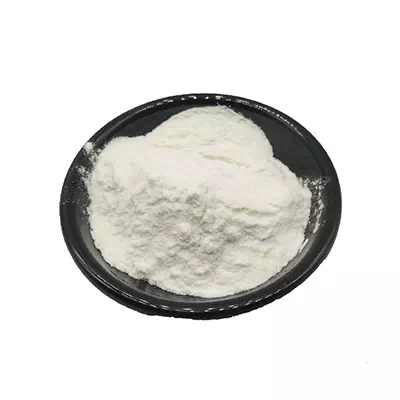

CAS number:9049-76-7
molecular formula:C24H42O21
molecular weight:666.57768
Starchhydroxypropylated;Starch 2-hydroxypropyl ether;Hydroxypropyl starch ether;5-[6-[[3,4-dihydroxy-6-(hydroxymethyl)-5-methoxyoxan-2-yl]oxymethyl]-5-[3-(2,3-dihydroxy-2-methylpropoxy)-4-hydroxy-6-(hydroxymethyl)-5-methoxyoxan-2-yl]oxy-3,4-dihydroxyoxan-2-yl]oxy-6-(hydroxymethyl)-2-methyloxane-3,4-diol;HYDROXYPROPYL STARCH;2-hydroxypropyl starch;Hydroxypropylstrke;Starch, hydroxypropyl ether
Thickeners; food additives; thickeners and gelling agents; food additives; pharmaceutical raw materials; additives; other raw materials; general goods
Hydroxypropyl starch ether is a white (colorless) powder with good fluidity and good water solubility. Its aqueous solution is transparent and colorless with good stability. It is stable to acid and alkali, the sintering temperature is lower than that of native starch, and the change of viscosity between hot and cold is more stable than that of native starch. Mixing with salt and sucrose has no effect on viscosity. After etherification, both ice-melt stability and transparency were improved.
Solubility | Practically insoluble in cold water and in ethanol (96 per cent). |
The natural starch of some grains or rhizomes (such as corn, sorghum, wheat, potato, cassava and sago) is treated with a small amount of certain kinds of chemicals to change its physical properties to meet special requirements. A class of starch derivatives.
Starch molecules are polymers of anhydrous glucose, with both linear and branched forms. Naturally occurring starches vary widely in their degree of polymerization and molecular weight. A certain kind of starch and different kinds of starch have different ratios of branched chain polymer (amylopectin) and straight chain polymer (amylose). These factors, together with the type of chemical modification used, significantly affect the viscosity, texture and stability of the starch sol.
According to the provisions of FAO/WHO (1997), modified starch includes the following (the manual number in parentheses):
Dextrin, Roasted Starch (10107), Acid Treated Starch (10130), Alkali Treated Starch (10131), Bleached Starch (10132), Oxidized Starch (10143), Enzyme Treated Starch (10135), Monostarch Phosphate (10141) , Distarch Phosphate (10134), Phosphorylated Distarch Phosphate (10144), Acetylated Distarch Phosphate (10129), Starch Acetate (10146), Acetylated Distarch Adipate (10127), Hydroxypropyl Starch (10139), Hydroxypropyl Distarch Phosphate (10138), Sodium Starch Octenylsuccinate (10147).
Modified starches are generally white or nearly white, tasteless, and odorless powders or granules, as well as pregelatinized (ie, heat-treated in the presence of water) flakes, amorphous powders, or meal. Insoluble in ethanol, ether and chloroform. If not pregelatinized, it is almost insoluble in cold water. When heated in water, it generally begins to swell at a temperature of 45 to 80°C, depending on the plant species and the degree of denaturation. Complete gelatinization at high temperature. Pregelatinized starch undergoes hydration in cold water.
● Thickener; Stabilizer; Binder; Emulsifier; Filler.
● as thickener. Our country stipulates that it can be used in jelly, luncheon meat, jam and soup, the maximum usage is 30g/kg; the maximum usage in ice cream is 12g/kg.
● Used for textile sizing, internal surface sizing, coating, food additives, pharmaceutical tablets or granules, feed bonding, etc.
● Used as printing and dyeing auxiliaries
● Thickener; Emulsifier; Binder. It can be used in gravy, soy sauce, meat filling, cold food, pudding, etc. to make the surface smooth and thick without granular structure.
● Stabilizer; Thickener; Filler; Binder.
● It is formed by esterification of acetic anhydride and adipic anhydride (≤0.12%) and starch.
● Starch milk is obtained by etherification reaction with propylene oxide (≤25%) under alkaline conditions, washing and drying.
● The starch is placed in the autoclave, a solvent (water) is added in proportion to adjust the concentration to 15%, and a 25% sodium hydroxide solution with a starch amount of 4% to 7% is added with stirring as a catalyst, and then N is introduced from the bottom of the reactor: about 10min to remove the air in the reactor. Finally, ethylene oxide (≤25%) was added, and the reaction was carried out at 110 °C for 90-120 min. After the reaction was completed, it was cooled to room temperature, the solvent was removed, and the product was concentrated and dried in vacuo.
● Starch is chemically denatured by a mild degradation reaction or by a reaction between the hydroxyl groups of native starch and the chosen chemical. One or more of the following methods can be used: mild oxidation (bleaching), moderate oxidation, acid depolymerization, monofunctional esterification, multifunctional esterification (crosslinking), monofunctional etherification, Multifunctional etherification reactions (crosslinking reactions), alkaline gelatinization and the combined use of these methods in some way (see individual monomers). These fabrication methods can serve as the basis for denaturing classification.
Sales hotline:

 Scan and consult wechat customer service
Scan and consult wechat customer service